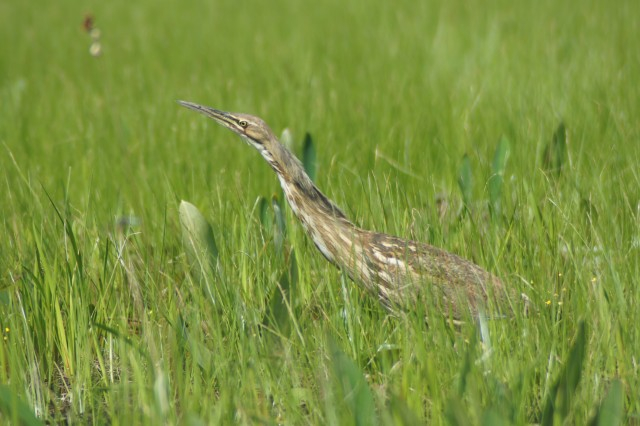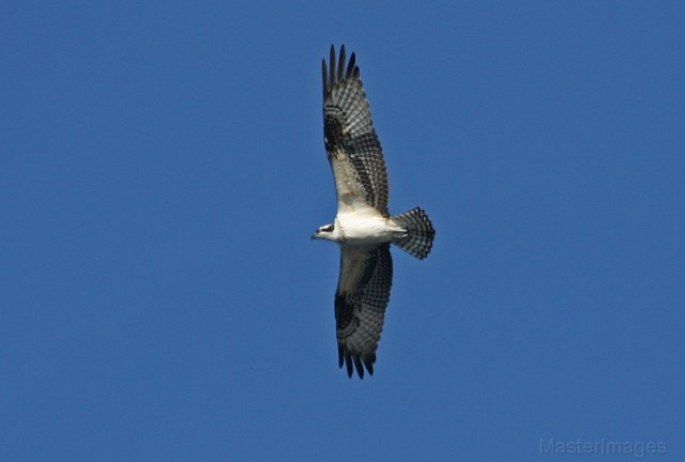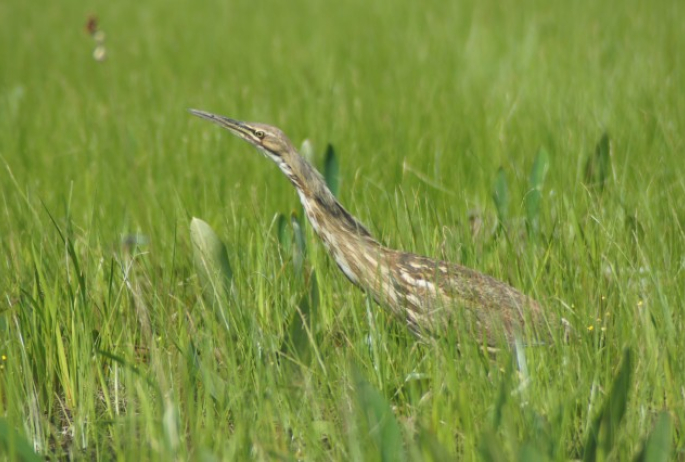Alan Belford
May 04, 2013
Each day of the advancing spring brings with it new arrivals. A brown thrasher fed at my bird feeders for five days and finally left earlier this week, and a few days ago I was excited to find an early indigo bunting feeding with the dark-eyed juncos at my feeders! As Wren and I take our daily afternoon and evening walks, we also continue to find recently arrived birds, such as yellow-bellied sapsuckers, blue-headed vireos, and palm warblers. It is an exciting time of year.
Earlier this week we went hiking north from the north end of the Bloomingdale Bog Trail (access is along Rt. 55 in Bloomingdale), an area with excellent boreal habitat. Our walk was even off to a good start during our drive, when I spotted a male American kestrel hunting in the fields near the town of Gabriels. After we started walking, I noticed a broad-winged hawk sitting on a snag. It unfortunately flew before I could get much of a photo. We continued north, listening to multiple yellow-rumped warblers and red-breasted nuthatches. Hermit thrushes also sang from shadowed perches – the first thrush to return to the area.

We walked a short ways down Bigelow Road to a stand of dead trees where black-backed woodpeckers can often be found. The road soon became a muddy mess, and rather than be forced to bathe Wren later that evening, I stopped in a dry area and hooted for barred owl, hoping to elicit an annoyed response from the woodpeckers. I got no response in return, and I abandoned my quest for easier quarry.
As we were reaching the junction of Bigelow Road and the bog trail, an osprey cruised high overhead – on its way north. It was followed shortly by a red-shouldered hawk – a species I don't see very often in the area – bringing us to four species of raptors on our short walk.
I stood and searched the ceilingless blue sky some more, but didn't pull out any more hawks. As we walked north from Bigelow, we found a gray jay quietly feeding along the trail. Usually gray jays are found in pairs or small groups, but I only noticed a single bird, and it eventually flew further into the woods. About a half mile above Bigelow there is an old beaver marsh on the east side of the trail, and I spotted an American bittern skulking, but moving fairly quickly across the beaver marsh. It seemed to be making for the small pool near the trail where a din of spring peepers was in full throat. I paused, watching it through the trees. But as I crept closer – and the bird was better than 100 meters away – the bittern appeared to spot us (Wren was moving around just ahead of me) and soon stood ramrod straight with its nose in the air.

We crept in a little closer behind a screen of trees and when we next saw the marsh, the bittern had moved, perhaps to hide. Then it suddenly lifted off about 80 meters away, and flew towards the back side of the marsh despite the fact that we were so far away. It was likely instinctively wary of dogs. We turned around rather than to disturb it further.
As we walked back to the car, we refound the gray jay – and this time we found the expected pair of birds. I watched them for a while, trying to photograph them, but for the most part they didn't come very close to the trail. We continued on and our hike was capped off when a distant barred owl hooted in the evening in the east beyond Bigelow Road. Not a bad way to end the day.


Packages and Promotions
Valid May. 1
- Oct. 31
Valid Dec. 6
- Nov. 1
Zip and Whip Expedition
Farmhouse UTVs
Experience Outdoors and Farmhouse UTVs have teamed up to bring your family and friends the Adirondack adventure you've been waiting for....
Valid Jun. 20
- Sep. 7
Valid Mar. 12
- Jun. 30
Guided Nature Immersions - 10% off for Pre-Season Registration
Adirondack Riverwalking & Forest Bathing
Picture it now...you are wading the Ausable River on a warm summer day, feel the cool water against you, hear the sounds of the birds and the...
Valid Dec. 1
- Dec. 1
Valid Dec. 1
- Dec. 1
Linger Longer in Saranac Lake
Best Western Saranac Lake
Linger Longer in Saranac Lake at our supremely located property, Best Western Saranac Lake. Stay 2 nights or more and get 15% off!
Valid Jan. 21
- Jan. 21
Valid Jan. 21
- Jan. 21
Stay and Dine
Voco Saranac Lake
Receive a 50 dollar credit per stay to use in our Boathouse Saranac Lake Pub. Enjoy an exceptional dining experience with unparalleled views great...
Valid Jan. 21
- Jan. 21
Valid Jan. 21
- Jan. 21
Pet Getaway
Voco Saranac Lake
Your dog deserves an Adirondack getaway too. Book our pet friendly hotel near Lake Placid welcomes every member of your crew. Book our Pet Package...
Valid Jan. 16
- Mar. 31
Valid Jan. 16
- Mar. 31
Hotel Saranac Ski & Stay Package
Hotel Saranac
Stay & Ski Package Stay at Hotel Saranac and Ski Titus Mountain Day or Night Package Your room reservation includes one adult lift ticket....
Valid Jan. 16
- Mar. 31
Valid Jan. 16
- Mar. 31
Hotel Saranac Sled & Spoke Package
Hotel Saranac
Snowmobile Package Hotel Saranac and Sara-Placid Sled & Spoke have partnered so you and a guest can explore dozens of miles of ADK snowmobile...
Valid Jan. 21
- Mar. 31
Valid Jan. 21
- Mar. 31
Titus Mountain Ski Package
Voco Saranac Lake
Enjoy your stay at the award winning voco Saranac Lake which includes two adult lift tickets at Titus Mountain Family Ski Center. Additional...










































































































































































































































































